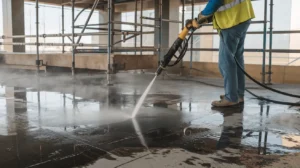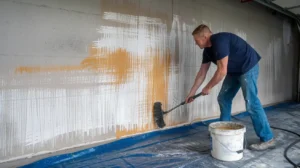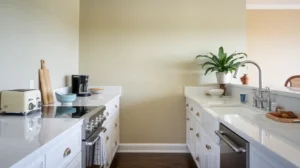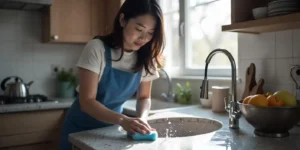How to Clean Concrete Floor | A Step-by-Step Guide for...
Read MoreTransformative DIY| Can You Paint Granite Countertops?
Can you paint granite countertops? This question may arise from a desire to refresh the appearance of your kitchen or bathroom without the expense of replacing the countertops entirely.
Painting granite countertops has become a popular option for those seeking a cost-effective and creative way to update their living spaces.
The motivation behind considering this method often stems from a desire to achieve a new aesthetic, match changing décor, or simply extend the lifespan of existing granite surfaces.
Can You Paint Granite Countertops?
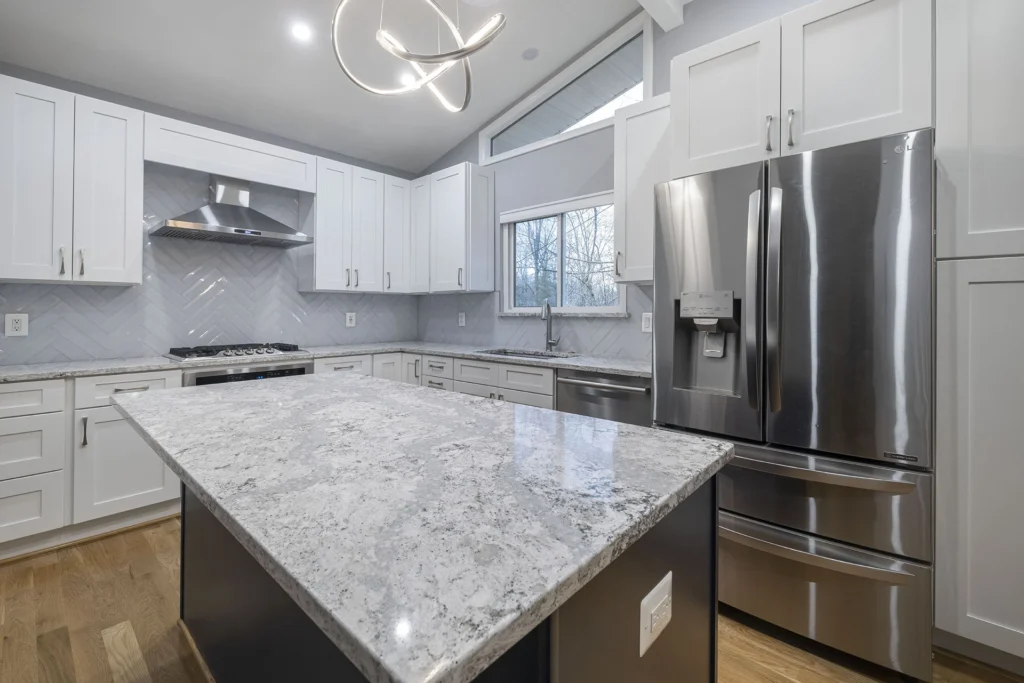
Painting granite countertops is a cost-effective way to update the look of your kitchen or bathroom without the expense of replacing the countertops. Here’s an overview of the process, suitable paint types, and steps involved:
Overview of the Process:
Clean the Surface: Begin by thoroughly cleaning the granite countertops. Use a mild detergent and water to remove any dirt, grease, or residues. Allow it to dry completely.
Surface Preparation: Sand the surface lightly with fine-grit sandpaper (around 220-grit) to create a slightly rough texture for better paint adhesion. Wipe away any dust with a damp cloth.
Priming: Apply a high-quality primer suitable for use on smooth surfaces. This helps the paint adhere well and ensures better durability. Allow the primer to dry completely according to the manufacturer’s instructions.
Choosing the Right Paint: Opt for a paint specifically designed for use on countertops or surfaces that receive heavy use. Epoxy or acrylic-based paints are often recommended for their durability and resistance to stains.
Painting: Apply the paint evenly using a high-quality brush or a foam roller. Be sure to follow the manufacturer’s instructions regarding drying times between coats. Multiple thin coats are preferable to one thick coat.
Sealing: Once the paint has dried completely, seal the countertops with a clear, water-based polyurethane or acrylic sealer. This helps protect the painted surface from scratches and stains.
Curing Time: Allow the countertops to cure for the recommended time before exposing them to heavy use. Curing times can vary depending on the type of paint and sealer used.
Types of Paint Suitable for Granite Surfaces:
Acrylic Paint: Water-based acrylic paints are a popular choice for painting countertops. They dry quickly, have low odor, and are easy to clean up.
Epoxy Paint: Epoxy paints provide a hard, durable finish that is resistant to stains and abrasion. They often come in kits with a primer and sealer for a comprehensive solution.
Chalk Paint: Chalk paint can be used on countertops with proper sealing. It provides a matte finish and may require additional steps like waxing for durability.
Steps Involved in Painting Granite Countertops:
Preparation: Clean and sand the surface, ensuring it is free of debris and contaminants.
Priming: Apply a suitable primer and let it dry completely.
Painting: Use a quality brush or roller to apply the paint in thin, even coats.
Drying: Allow each coat to dry thoroughly before applying the next one.
Sealing: Apply a clear sealer to protect the painted surface.
Curing: Allow the countertops to cure according to the manufacturer’s recommendations before regular use.
Can You Paint Granite Countertops To Look Like Quartz
While it is possible to paint granite countertops to resemble quartz, there are important considerations and steps to follow to achieve a realistic and durable finish. Here’s a step-by-step guide to help you achieve a quartz-like finish on your granite countertops:
Materials Needed:
Cleaner/Degreaser: To clean the countertops thoroughly.
Fine-grit Sandpaper: For roughening the surface.
Primer: A bonding primer suitable for countertops.
Acrylic Paints: High-quality acrylic paints in quartz-like colors.
Sea Sponge or Feathering Brush: For creating a natural stone texture.
Clear Sealant or Topcoat: To protect the painted surface.
Painter’s Tape: To protect surrounding areas.
Drop Cloths or Plastic Sheets: To protect floors and cabinets.
Steps:
Clean the Countertops: Use a cleaner/degreaser to thoroughly clean the countertops. Remove any grease, grime, or residue.
Sand the Surface: Lightly sand the surface with fine-grit sandpaper to create a slightly rough texture. This helps the primer adhere better.
Apply Primer: Apply a bonding primer specifically designed for countertops. Follow the manufacturer’s instructions regarding drying time.
Base Coat: Apply a base coat of acrylic paint in a color that closely resembles quartz. Let it dry completely.
Sponge Painting: Use a sea sponge or feathering brush to create a natural stone texture. Dab or lightly stroke on different shades of acrylic paint to mimic the veining and patterns found in quartz. Refer to reference images of quartz countertops for inspiration.
Veining Detail: Use a fine brush to add veining details in contrasting colors. Quartz often has subtle veins running through it, and replicating this detail will enhance the realism.
Protect Surrounding Areas: Use painter’s tape to protect areas around the countertops, such as cabinets and walls. Cover the floors with drop cloths or plastic sheets.
Topcoat/Sealant: Once the paint is completely dry, apply a clear sealant or topcoat specifically designed for countertops. This will protect the painted surface from daily wear and tear.
Cure Time: Allow the countertops to cure for the recommended time before using them. Follow the instructions on the sealant for curing times.
How To Paint Granite Countertops: Step-by-Step Guide
Painting granite countertops can be a cost-effective way to update the look of your kitchen or bathroom. Follow this step-by-step guide for a successful painting project.
Materials and Tools:
Granite Countertop Paint Kit: Look for a high-quality granite countertop paint kit that includes a primer, paint, and clear sealer.
Sandpaper (220-grit): To lightly sand the surface and ensure proper adhesion of the primer.
Painter’s Tape: For masking off areas you don’t want to paint.
Drop Cloths or Plastic Sheets: To protect surrounding surfaces from paint splatter.
TSP (Trisodium Phosphate) Cleaner: For cleaning and degreasing the countertop surface.
Lint-Free Cloths: To wipe down the surface after cleaning.
High-Quality Paintbrush or Foam Roller: Depending on your preference and the texture of your countertop.
Clear Sealant: To protect the painted surface and add durability.
Step-by-Step Guide:
Step 1: Clean the Countertop
- Remove any items from the countertop.
- Mix TSP cleaner with water according to the instructions.
- Clean the countertop thoroughly to remove grease, dirt, and any residues.
- Rinse with clean water and allow it to dry completely.
Step 2: Sand the Surface
- Use 220-grit sandpaper to lightly sand the entire surface.
- Wipe away dust with a clean, dry cloth.
Step 3: Apply Primer
- Follow the instructions on the primer included in the kit.
- Apply an even coat of primer to the entire countertop surface.
- Allow the primer to dry completely according to the recommended drying time.
Step 4: Paint the Countertop
- Stir the paint thoroughly.
- Use a high-quality paintbrush or foam roller to apply the paint evenly.
- Apply additional coats as needed, allowing each coat to dry completely.
Step 5: Add Texture (Optional)
- Some kits include texture additives for a more realistic granite appearance.
- Follow the kit instructions for adding texture if desired.
Step 6: Seal the Surface
- Once the paint is completely dry, apply the clear sealant according to the kit instructions.
- Allow the sealant to cure for the recommended time before using the countertop.
Step 7: Finishing Touches
- Remove painter’s tape carefully.
- Check for any touch-ups or uneven areas and fix as needed.
- Allow the countertop to cure completely before placing items on it.
Tips:
Ventilation: Ensure proper ventilation during the painting process.
Follow Kit Instructions: Always follow the specific instructions provided in the paint kit for the best results.
Curing Time: Allow ample time for each layer to dry and cure before proceeding to the next step.
Maintenance: Use a mild, non-abrasive cleaner for routine cleaning to preserve the painted surface.
Advantages And Disadvantages Of Painting Granite Countertops
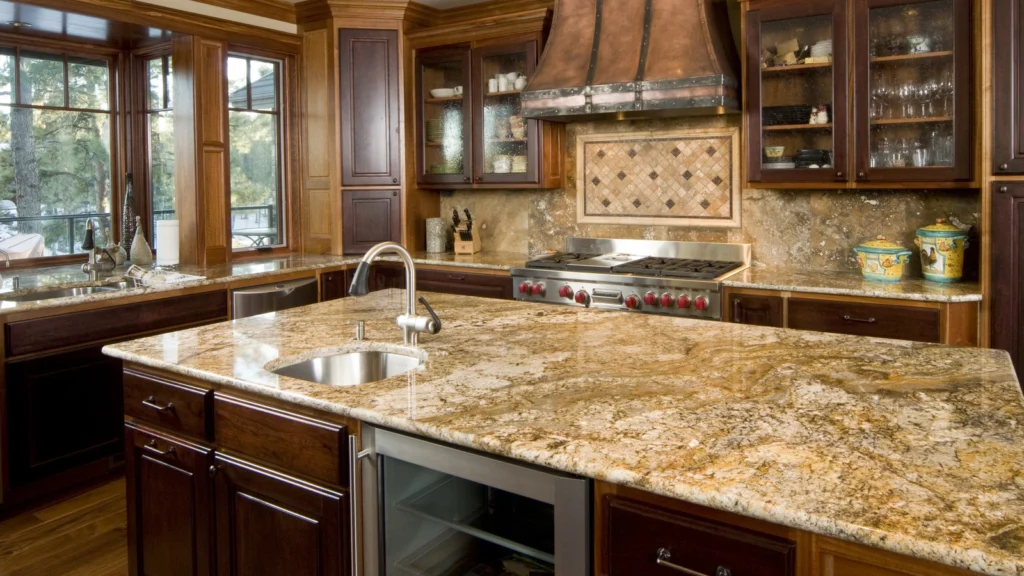
Advantages:
Cost-Effective: Painting granite countertops is generally more affordable than replacing them entirely. It allows you to achieve a new look without the high cost of purchasing and installing new countertops.
Customization: Painting provides a wide range of color options, allowing you to customize the appearance of your countertops to match your preferred style and decor.
Quick Transformation: Painting is a relatively quick process compared to other countertop renovation options. You can complete the project in a shorter time frame, minimizing disruption in your kitchen or bathroom.
DIY Potential: Some homeowners choose to paint their granite countertops as a do-it-yourself (DIY) project. This can further reduce costs, as you won’t need to hire professionals for installation. If you want professional guidance then Stone Sealer Restoration is best in business.
Temporary Solution: If you’re not ready for a long-term commitment to a particular countertop color, painting allows for a temporary change. You can easily repaint or revert to the original granite if desired.
Disadvantages:
Durability Concerns: Painted surfaces may not be as durable as natural stone, and the finish may wear over time, especially in high-traffic areas. Scratches and chips are also more likely to occur.
Limited to Solid Colors: Achieving intricate patterns or the natural veining found in granite can be challenging with paint. Painted countertops usually result in a solid color or simple pattern.
Surface Preparation: Properly preparing the granite surface is crucial for the paint to adhere correctly. Without proper preparation, the paint may not bond well and could peel or chip.
Maintenance Challenges: Painted surfaces may require more maintenance to preserve their appearance. Special cleaning agents may be necessary, and reapplication of a protective sealant may be needed periodically.
Long-Term Viability: While painting can provide a quick fix, it might not be a long-term solution. Over time, the paint may show signs of wear, and you might eventually need to consider more permanent countertop solutions.
Conclusion
The decision to paint granite countertops is a multifaceted one that involves considering various factors. Firstly, it’s crucial to acknowledge that painting can provide a cost-effective alternative to replacing countertops, allowing for a fresh aesthetic without the expense of a complete overhaul.
Additionally, the process can be a DIY project, further reducing costs. However, it’s essential to weigh the potential drawbacks, such as the durability of the paint and its ability to withstand daily wear and tear in a high-traffic area like the kitchen. Feel free to contact us for any type of services or query like can you paint granite countertops.
FAQs
Can I Really Paint My Granite Countertops?
Yes, you can paint granite countertops to give them a new look. However, it’s important to follow the right steps and use appropriate materials for a durable finish.
What Type Of Paint Should I Use For Granite Countertops?
Use a high-quality, acrylic, or epoxy paint specifically designed for surfaces like countertops. Ensure it is compatible with granite and can withstand daily wear and tear.
Do I Need To Prepare The Granite Surface Before Painting?
Yes, thorough cleaning and proper surface preparation are crucial. Clean the countertops, sand lightly to create a suitable surface for paint adhesion, and apply a primer if recommended by the paint manufacturer.
Can I Choose Any Color For Painting My Granite Countertops?
While you have many color options, it’s advisable to choose a color that complements your kitchen or bathroom décor. Lighter colors may require more maintenance to avoid visible stains.
Is It A Diy-Friendly Project, Or Should I Hire A Professional?
Painting granite countertops can be a DIY project, but it requires careful preparation and attention to detail. If you’re unsure or want a flawless finish, hiring a professional painter is an option.
How Durable Is Painted Granite Compared To Natural Granite?
While painted granite can provide a durable finish, it may not match the durability of natural granite. Properly applied and sealed paint can withstand regular use, but it may require occasional touch-ups.
Our Services
Our Recent Post
Top 7 Popular Quartz Countertops Colors in 2024
Top 7 Popular Quartz Countertops Colors in 2024 Quartz countertops...
Read MoreHow to Clean a Granite Composite Sink | Simple Steps for a Spotless Finish
How to Clean a Granite Composite Sink | Simple Steps...
Read More
